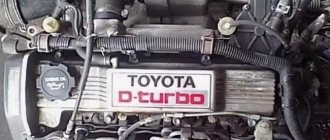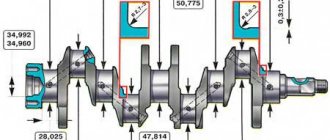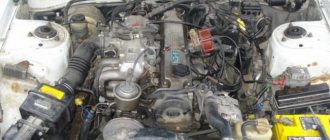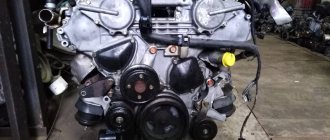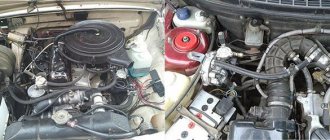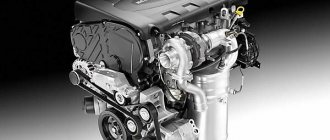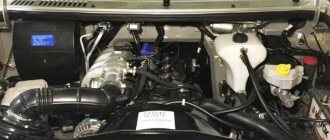14.04.2019
Author of the article: SkodaKodiaq.club
gasoline engines
Over the past quarter century, powertrain design has evolved rapidly. What were the best gasoline engines of that period?
Gasoline engines have been the primary source of power for passenger cars for 80 years. Later, the share of diesel units systematically increased. The boom in diesel engines erupted after the introduction of Common Rail power, and since 2005 they have been increasingly ordered from gasoline engines. Currently, the scales are again leaning towards gasoline. Thanks to the reduction, they have become more economical and are significantly superior to powerful diesel engines also in the purity of exhaust gases, which require the use of increasingly expensive equipment.
Are the best gasoline engines old or new?
In the 90s, turbocharged petrol engines were still a rarity, reserved for justifiable versions. They quickly grew in number with heads having four valves per cylinder, and sometimes also variable valve timing systems, which helped produce high power. Naturally aspirated engines of this period typically had linear characteristics, and their eagerness to perform increased with rotation. Durability with proper maintenance was high.
The real breakthrough occurred in 2005-2009, when Euro IV and Euro V emissions standards were introduced, and with them it was necessary to use, in particular, the EGR exhaust gas recirculation system, which reduced the amount of nitrogen oxides released. There has been a systematic increase in the popularity of direct injection units, which reduce combustion - necessary for the brand to meet average carbon dioxide emissions expectations for a number of vehicles. Unfortunately, not all new solutions have been successful in terms of durability. Especially the first engines with direct injection (for example, 1.4/1.6/2.0 FSI of the Volkswagen group) had problems with air deposits in the intake system.
Types of gasoline internal combustion engines
Currently, cars can be found with gasoline engines equipped with:
- carburetor, where fuel and air are mixed. Then the prepared mixture is fed into the cylinders, where it is ignited by a spark that jumps between the electrodes of the spark plugs.
- injection mixture formation system, which is carried out by injecting the fuel-air mixture into the intake manifold or directly into the engine cylinders. For this, special nozzles are used. In this case, there are systems:
- mono fuel injection (single point).
- distributed fuel injection (multipoint).
The injectors can be controlled and fuel dosed using:
- Lever-plunger mechanism - in mechanical injection systems.
- A special ECU control unit - in electronic injection systems.
- A supercharging system, when the intake of a combustible mixture or air occurs under pressure pumped by a turbocharger. At the same time, the power and efficiency of the power unit increases significantly.
A special place among gasoline engines is occupied by the rotary piston engine (Wankel engine). It differs from other internal combustion engines in the absence of a separate gas distribution mechanism, which greatly simplifies the design of the engine.
The principle of operation of the rotary piston power unit is that it performs three full operating cycles in one revolution. This happens due to the fact that the engine is based on an original triangular rotor, which, rotating in a specially shaped chamber, performs the functions of a piston, crankshaft and gas distribution mechanism. For a number of structural and technological reasons, this gasoline engine was not widely used.
In the automotive industry, in-line four-cylinder four-stroke gasoline power units are most often used, differing from the rest:
- large resource;
- environmentally friendly exhaust;
- efficiency;
- low noise level.
Engine YaMZ-6585
It is part of a family of eight-cylinder V-shaped diesel engines produced by the Yaroslavl Motor Plant. Four-stroke diesel engine with compression ignition, direct fuel injection, supercharged, liquid-cooled, mechanical speed controller, designed for installation of a charge air cooler (mounted on the product).
The YaMZ-6585 engine is used in MAZ cars, chassis, dump trucks, road trains and truck tractors.
After 2010, almost every new generation engine was already equipped with turbocharging, direct injection and smart liquid/oil pumps, that is, a package of solutions to improve engine warming, reducing the resistance of its operation and fuel consumption. Another sign of the times was the rise of direct fuel injection technology. This solution made it possible to increase combustion pressure while maintaining low fuel octane requirements. The result is improved efficiency (12% according to Bosch) without negatively impacting productivity. If earlier some manufacturers experimented with direct fuel injection in gasoline engines (for example, Mitsubishi, Renault), then in this decade most companies began to do this. In the second half of the decade, first-degree reduction became common, which means – in the case of popular engines – without reducing the number of cylinders. The reductions, usually associated with the introduction of turbocharging, have reduced fuel consumption by several percent.
Which engines are solid and deserve special praise? The opinions of drivers and experts, of course, are divided. In our review, we tried to describe engines in popular language, talk about those that have the best characteristics and can withstand long mileages.
Design of gasoline internal combustion engines
A detailed examination of the classification of gasoline internal combustion engines, their key elements, as well as the general principle of operation will be carried out further, but now, for a quick introduction, a brief overview of the design and functionality of the main parts of this type of unit will be presented in general terms.
The air mixture enters the combustion chamber when air is supplied in parallel with a change in the vector of movement of the piston in the direction of the upper extreme point. Initially, when starting the engine, the piston begins its movement from this point to the lower extreme point, thanks to the rotation of the crankshaft (crankshaft).
During one revolution of the crankshaft, a number of sequential operations are performed, namely: the piston, during its movement, acts on the air-fuel substance, compressing it, after which, when the piston is in the uppermost position, the mixture is forcibly ignited. Gasoline vapors expanding during the combustion process force the piston to rush again to the opposite extreme mark. During the power stroke, all valves are blocked.
Saab 2.3 B23
- Installed in: Saab 900, 9000, 9-3, 9-5
- Years of manufacture: 1990-2010
- Volume: 2290 cm3
- Power max: 150-260 hp
- Service life: about 600 thousand liters. With.
Main design features:
- - cast iron block
- — chain distributor-16 valves
- -two balancing shafts.
Saab 2.3 B23
Deprived of solutions from the General Motors concern, the Saab engine was supercharged and supercharged, low or high pressure. The engine is a two-liter B20 block. The turbo versions impress with their flexibility for tuning - which, incidentally, was what Saab used when creating sports versions of cars (Aero, Viggen). The biggest drawback of the unit is the ignition cartridge - an assembly of coils mounted on top of the engine. Does not work on LPG (liquefied gas). You will have to pay more than 13 thousand rubles for a new cartridge. During operation, you should be interested in the patency of the crankcase ventilation system. A clogged air line can cause the engine to burn out. A close relative of the 2.3 B23 engine is the two-liter B20 block. Has the same disadvantages and advantages as a larger motor.
The principle of operation of a gasoline engine
Gasoline engines are two- and four-stroke. The uninterrupted operation of their operating system is ensured by the established cyclicity, i.e. a certain working cycle of successive stages replacing each other - cycles of converting fuel substance into energy in one cranking (on two-stroke engines the working process - cycle, occurs with greater integration of processes and differs in fuel consumption and generated power).
So you:
- Inlet;
- Compression;
- Working stroke;
- Release.
The essence of this operating mechanism comes down to the combustion process of the air-fuel mixture in a special combustion chamber, i.e. in an isolated space. When the piston moves from top dead center to bottom, the intake valves open and the fuel mixture is supplied to the combustion chamber. There, the substance mixture is forcibly ignited by a spark and the pistons, repelled by the expansion of gases, move to the lowest point.
As a result of combustion of the fuel mixture, energy is generated to turn on and maintain the mechanical operation of the engine. The piston, through a crank mechanism, transmits movement to the crankshaft, which imparts torque to the wheels of the car. Exhaust gases, which are a residual product of vehicle combustion, are directed into gas distribution channels and removed.
Subaru EJ20/EJ205
- Installed in: Subaru Forester, Legacy, Impreza
- Years of production: 1989-2006
- Volume: 1994 cm3
- Max power: 115-275 hp
- Service life: about 450 thousand. km.
Main design features:
- – aluminum block
- – cylinder arrangement (boxer)
- – belt driven motor –
- indirect fuel injection.
Subaru's iconic boxer sounds beautiful and is durable. In petrol versions it turns out to be practically “impenetrable”. Much earlier, gearbox or body bearings covered with rust fail. The old EJ20 engines, as well as the younger EJ205, were produced in turbocharged versions - and were easy to tune. Anyone who wants to enjoy high power must accept the risk of damaging the engine, for example by rotating the acetabulum. This, however, applies to attempts to overclock completely production engines. If the boxer is equipped with reinforced components, then even after tuning it can last a long time. The problem, it turns out, is gas equipment. They can be installed and, after proper design, enjoy low fuel costs, however, in the turbo version, the problem arises when adjusting the valve clearance - to perform this operation, you must remove the engine from the car.
engine
Basic auxiliary systems of a gasoline engine
Systems specific to gasoline engines
- Ignition system - ensures that the fuel is ignited at the right time. It can be contact, contactless or microprocessor-based. The contact system includes: switch-distributor, coil, ignition switch, spark plugs. A non-contact system includes the same equipment, but instead of a breaker there is a Hall sensor or an induction sensor. The microprocessor ignition system is controlled by a special computer unit; it includes a crankshaft position sensor, an ignition control unit, a switch, coils, spark plugs, and an engine temperature sensor. For an injection engine, a throttle position sensor and a mass air flow sensor are added to this system.
- The air-fuel mixture preparation system is a carburetor or an injection system.
Fiat 1.2 FIRE
- Installed in: Fiat Marea, Siena, Bravo, Palio Weekend, Punto, Punto II, 500 Years of manufacture: since 1993.
- Volume: 1242 cm3
- Power max: 60-86 hp
- Service life: about 300 thousand. km
Main design features:
- – cast iron block
- – belt driven motor
- – 8 or 16 valves
- – central injection (SPI 60 KM versions) or multi (MPI 75 HP and 16V versions)
This engine is famous for its ease of repair and durability - during normal operation, problems with the 1.2 FIRE engine are limited mainly to replacing the generator (prone to cracking of the housing), connecting new seals - gasoline spills are common. Oil wear is also a problem with the engine. Given the current values of vehicles, major repairs have no economic justification. If the driver constantly refills the oil, its combustion does not affect the service life of the engine. In addition to the common 1.2 FIRE engine, Fiat also had an accompanying 1.1/1.4 FIRE engine.
engine
Volkswagen 1.8T
- Installed in: Audi A3, A4, A6, TT, Seat Ibiza, Leon, Exeo, Skoda Superb and Octavia, VW Bora, Passat B5, Polo GTI, Golf IV.
- Years of production: 1994-2010
- Volume: 1781 cm3
- Max power: 150-240 hp
- Service life: about 500 thousand. km
Main design features:
- – cast iron block
- – belt drive motor
- – 20 valves
- – turbocharging
- – individual ignition coils.
Volkswagen
A very popular engine that found its way under the hood of many Volkswagen models. The 1.8 T engine successfully combines dynamics, flexibility and reasonable combustion, which in the combined cycle is within 10 l / 100 km. Operating costs can be significantly reduced by installing gas equipment, with which the 1.8 T engine works perfectly. Sometimes this fact can be overestimated - complete neglect of maintenance sooner or later ends in serious technical problems.
BMW M52
- Installed in: BMW 3 E36/E46, 5 Series E39, 7 Series E38, Z3
- Years of production: 1994-2000
- Volume: 1991-2793 cm3
- Max power: 150-193 hp
- Shelf life: about 500 thousand. km
Main design features:
- – aluminum block
- – chain motor
- – variable valve timing (Vanos)
- – 24 valves
- – 6 cylinders,
- multipoint injection.
BMW
Popular and used in many BMW models. The engine is durable and withstands even severe abuse and consumables or the need to drive on LPG. The best option is considered to be the most powerful, 193 hp. version M52B28TU with a volume of 2.8 liters, which appeared in the lineup in 1998. M52 engines were available as two-liter (M52B20, 150 hp) and 2.5 engines (M52B25, 170 hp).
Key elements of a gasoline engine
These are:
- The combustion chamber is the engine element into which the fuel mixture is supplied and where the process of combustion and energy production directly occurs.
- A piston is an element equipped with cast iron sealing rings that performs a reciprocating motion, squeezing the mixture and pushing expanding gases into the gas distribution system. The use of rings helps achieve optimal compression in the cylinders. The piston is also part of the crank mechanism.
- A connecting rod is an element made of aluminum or high-strength steel. Provides connection between the piston and the crankshaft. Has working two-way rotation.
- The crankshaft is the part of the engine that ensures the rotation of the car's wheels by converting the translational movement of the piston.
- The spark plug is an electrical element responsible for igniting the fuel substance in the chamber during the rise of the piston to TDC.
- The valve system - includes intake valves - allow the intake of air mass, and exhaust valves - participate in the process of removing exhaust gases.
BMW M54
- Installed in: BMW 3-series E46, 5-series E39/E60, 7-series E65, Z3, Z4, X3 E83, X5 E53
- Years of production: 2000-2006
- Volume: 2171/2494/2979 cm3
- Max power: 170-231 hp
- Service life: about 500 thousand. km
Main design features:
- – aluminum block
- – 24 valves
- – variable valve timing (intake/exhaust)
- – multi-point injection.
BMW M54
The M54 is a family of BMW's well-reputed six-cylinder engines with capacities of 2.2, 2.5 and 3.0 liters. The most valuable and in demand is the “three-liter” with a capacity of 231 hp. It’s not just the car that matters, but also the engine itself – it’s often missed from broken down cars, for weaker cars. A recurring problem with M54 engines is the tendency to burn significant amounts of oil. This can be reduced by replacing or cleaning the ductwork.
Citroen-Peugeot 1.6 TU5JP4
- Installed in: Citroen C3, C4, Xsara, Picasso, Peugeot 206, 207, 307, Citroen C2 VTS
- Years of production: 2000-2009
- Volume: 1587 cm3
- Max power: 109-122 hp
- Service life: about 500 thousand. km
Main design features:
- – cast iron block
- – belt driven motor
- – 16 valves
- – multi-point injection
- – intake manifold made of plastic or metal.
Citroen-Peugeot 1.6 TU5JP4
1.6 TU5JP4 engine, deservedly called “armored”. Even the installation of gas equipment does not harm it, and serious failures, while maintaining minimal maintenance, are extremely rare. “Extremely rare” - here we are talking, first of all, about the malfunction of the fittings. During longer runs, the engine may consume more oil. The block has often been praised for its work culture and performance - but it lacks pulling power even at low revs.
Operating cycle of a gasoline engine[ | ]
Duty cycle of a four-stroke engine[ | ]
As the name suggests, the working cycle of a four-stroke engine consists of four main stages - strokes
.
1. Inlet.
The piston descends from top dead center (TDC) to bottom dead center (BDC).
At the same time, the camshaft cams open the intake valve, and through this valve a fresh fuel-air mixture is sucked into the cylinder. 2. Compression.
The piston moves from BDC to TDC, compressing the working mixture.
In this case, the temperature of the mixture increases significantly. The ratio of the working volume of the cylinder at BDC to the volume of the combustion chamber at TDC is called the compression ratio. The compression ratio is a very important parameter; usually, the higher it is, the greater the fuel efficiency of the engine. However, an engine with a higher compression ratio requires higher octane fuel, which is more expensive. 3. Combustion and expansion
(piston stroke).
Shortly before the end of the compression cycle, the air-fuel mixture is ignited by a spark from the spark plug. During the piston's journey from TDC to BDC, fuel burns, and under the influence of the heat of the burned fuel, the working mixture expands, pushing the piston. The degree to which the engine crankshaft is “underrotated” to TDC when the mixture is ignited is called the ignition timing angle. Ignition timing is necessary so that the bulk of the fuel-air mixture has time to ignite by the time the piston is at TDC (the ignition process is a slow process relative to the speed of operation of the piston systems of modern engines). In this case, the use of energy from burned fuel will be maximum. Fuel combustion takes almost a fixed time, so to improve engine efficiency, you need to increase the ignition timing as the speed increases. In older engines, this adjustment was made by a mechanical device, a centrifugal vacuum regulator acting on a breaker. More modern engines use electronics to adjust the ignition timing. In this case, a crankshaft position sensor is used, usually operating on an inductive principle. 4. Release.
After BDC of the operating cycle, the exhaust valve opens and the upward moving piston displaces the exhaust gases from the engine cylinder. When the piston reaches TDC, the exhaust valve closes and the cycle begins again.
It must also be remembered that the next process (for example, admission) does not necessarily have to begin at the moment when the previous one (for example, exhaust) ends. This position, when both valves (intake and exhaust) are open at once, is called valve overlap. Overlapping the valves is necessary for better filling of the cylinders with the combustible mixture, as well as for better cleaning of the cylinders from exhaust gases.
Duty cycle of a two-stroke engine[ | ]
In a two-stroke engine, the entire working cycle occurs within one revolution of the crankshaft. compression remains from the four-stroke engine cycle
and
extension
.
Intake and exhaust are replaced scavenging
near the bottom dead center of the piston, at which fresh working mixture displaces exhaust gases from the cylinder.
In more detail, the engine cycle is structured as follows: when the piston goes up, the working mixture in the cylinder is compressed. At the same time, the upward moving piston creates a vacuum in the crank chamber. Under the influence of this vacuum, the intake manifold valve opens and a fresh portion of the air-fuel mixture (usually with the addition of oil) is sucked into the crank chamber. As the piston moves downward, the pressure in the crank chamber increases and the valve closes. Ignition, combustion and expansion of the working mixture occur in the same way as in a four-stroke engine. However, when the piston moves downwards, approximately 60° before BDC, the exhaust window opens (meaning, the piston stops blocking the exhaust window). Exhaust gases (which still have high pressure) rush through this window into the exhaust manifold. After some time, the piston also opens the inlet window located on the side of the intake manifold. The fresh mixture, pushed out of the crank chamber by the downward piston, enters the working volume of the cylinder and finally displaces the exhaust gases from it. In this case, part of the working mixture may be discharged into the exhaust manifold. When the piston moves upward, a fresh portion of the working mixture is sucked into the crank chamber.
It can be noted that a two-stroke engine with the same cylinder volume should have almost twice the power. However, this advantage is not fully realized due to the insufficient efficiency of scavenging compared to normal inlet and outlet. The power of a two-stroke engine of the same displacement as a four-stroke engine is 1.5 - 1.8 times greater.
An important advantage of two-stroke engines is the absence of a bulky valve system and camshaft.
